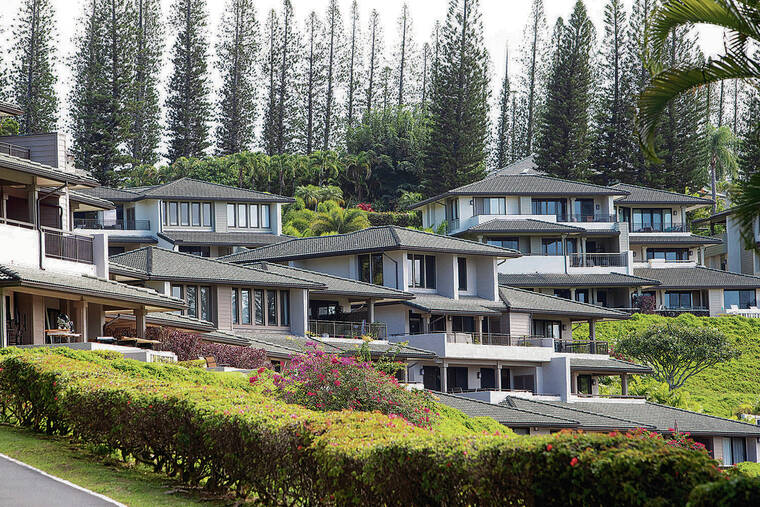Column: Act on permanent housing solutions for local people

CINDY ELLEN RUSSELL / DEC. 15
Many units at the Kapalua Golf Villas in Lahaina are used for short-term vacation rentals.

COURTESY PHOTO
Magdalena Granillo


Note: In the difficult months following the Aug. 8, 2023, wildfires that devastated Lahaina, education was disrupted significantly. But amid the struggles, students and educators persevered — and the learning and classwork resumed.
At Lahainaluna High School this past school year, teacher Jarrett Chapin tasked his English/Language Arts sophomores to research topics related to local problems and to write speeches, project proposals and op-eds about their issues.
Today, we present abridged versions of three of those pieces. All reflect the diligence, learning and critical thinking being done by Lahaina’s youth even as they, and their community, strive for recovery amid ongoing challenges.
About 28.6% of Maui residents spend half or more of their income on rent; they are considered severely rent-burdened. And then on Aug. 8, 2023, a deadly wildfire destroyed the places where they lived and worked. 1,892 residential buildings were destroyed and around 300 businesses were destroyed. 10,000 Lahaina residents were suddenly displaced. Of that 10,000, approximately 3,100 were still living in temporary accommodations, including hotels, as of April.
The housing crisis is a topic that has been around for years on Maui. There are many different layers to the crisis, and therefore many solutions to it. Over the years there have been attempts at solutions, but not enough has been done. That needs to change. Residents will continue to struggle unless solutions are tested, proven successful, and then put into action through legislation.
For years Maui residents have struggled with high rent prices, the limited amount of housing, increasing amount of homelessness or the limits of new construction. The deadly Lahaina fire has exacerbated these issues. A year after the fire, there are still residents without new housing.
Don't miss out on what's happening!
Stay in touch with breaking news, as it happens, conveniently in your email inbox. It's FREE!
Rent prices have been increasing for years and will continue to increase. With the high living costs, many residents work multiple jobs just to support themselves or their families. After paying for rent and utilities, many residents don’t have much left over, if anything at all. On average, you should be spending one-third of your income on rent, not one-half.
If you make $2,800 every month and have a rent of $2,400, you are left with $400 to spend on other necessities like bills and food; $400 does not provide a quality life. Residents cannot live like this much longer. Something needs to change. Rent prices must be lowered if residents are to continue living on Maui.
>> RELATED: Column: Water is precious resource for all of public to share
>> RELATED: Column: Rebuild coral reefs that help prevent coast erosion
Completely solving the housing crisis will take years. The current solutions regarding displaced residents after the fire include making tiny home communities and turning short term vacation rentals into long-term housing. Also, the proposal of the Interim Housing Plan has a goal of providing 3,000 safe and stable homes available for displaced residents. These would all be beneficial as solutions toward the housing crisis, and are steps in the right direction.
An enormous part of the solution requires adjustment to the cost of housing on Maui for both owners and renters. Out of the 50 United States, Hawaii is the most expensive state to live in with Maui being one of the most expensive islands. Lowering the cost of housing is easy to say but much harder to accomplish. With the high demand and low supply of housing, the costs keep increasing, when residents are already struggling to afford to live here as it is.
One thing that could be a solution is building affordable, or workforce, housing. Workforce housing helps anyone who makes between 60% and 120% of area median income (AMI), defined as the midpoint of a specific area’s income distribution. The target of workforce housing is middle-income workers, like teachers, firefighters, health care workers and retail clerks.
Some people might say that displaced residents are getting off easy for living in hotels for so long. Or that if you can’t afford your rent, you should just get a new job, or move off island, and start over. Yes, displaced residents are thankful to be in the hotels rather than couch surfing or camping. Yet, they have been calling a hotel room a home for the last year and are understandably tired of it. Finding a new job can be hard, it always has been. Add the fact that a lot of businesses were burned in the fire, and now finding a job seems nearly impossible. For many of the displaced residents, Maui is their home. Some residents know little else. They don’t want to and shouldn’t have to leave.
The housing crisis has gone on long enough, there needs to be more action. There needs to be more focus on finding permanent solutions, not temporary solutions. Residents need to continue to talk about, and protest, the housing crisis for there to be a large impact on the problem. As a community in crisis, we need to come together and fight the problem head on. Let’s act with purpose.
Magdalena Granillo was a sophomore last year at Lahainaluna High School.




